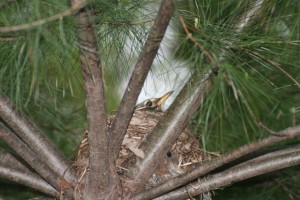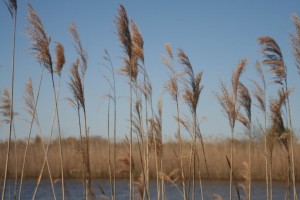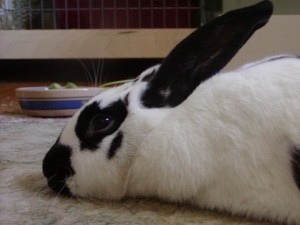
My sweet Dora passed away today. The poem below is one I found in a nice little book called Life Prayers. I send along a handwritten copy with my bunnies any time they go to the vet’s. It is a prayer for healing written by Elias Amidon.
Friend, you lie quiet,
watching the dawn light color your heart,
dreaming of healing for your hurt body
laying there unanswerable to your will.
You breathe deep and your breath has two sides:
inside and outside. You are on both, being breathed.
The future approaches. You will heal or
you will go back to being God.
Which will you do?
Oh by all that is beautiful–
May it be that you live!
May your body heal happy and whole!
May energy fill and delight you!
May we join the dance your presence gives!
May you live!
And if you die?
Oh dear self, by all that is beautiful,
Know you are Safe! Everything is All Right
Forever and Ever and Ever!
The most wonderful, exquisite, familiar
Truth is what is True, and welcomes you.
It will be very easy.
You lie quiet now, praying.
A great healing is coming
and you want to be ready.
The colors of your heart blend
with the light of the morning.
You are blessed.
Robin on nest
Beloved of children, bards and spring,
O birds, your prefect virtues bring,–
Your song, your forms, your rhythmic flight,
Your manners for the heart’s delight;
Nestle in hedge, or barn, or roof;
Here weave your chamber weather-proof.
Forgive our harms and condescend
To man, as to a lubber friend,
And, generous, teach his awkward race
Courage and probity and grace!
–Ralph Waldo Emerson, Birds, 1867
I was surprised to find this robin nesting right under my nose and wonder how many times I walked by without noticing her there. The babies have since fledged and I hear them begging to be fed from the low shrubs around the yard. I often see one of them in the vegetable garden, where the dirt is moist and full of worms.
Mister Mimic
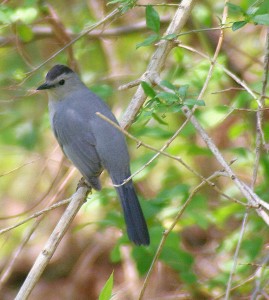 “Other migrants come and go, but the catbird comes with the violets and stays for the late asters, and virtually all the time he is here he contributes to the gaiety of his neighbors. He is here now, and he is in fine form, celebrating the sunshine, jeering at the rain, demanding attention and deserving it.
“Other migrants come and go, but the catbird comes with the violets and stays for the late asters, and virtually all the time he is here he contributes to the gaiety of his neighbors. He is here now, and he is in fine form, celebrating the sunshine, jeering at the rain, demanding attention and deserving it.
He is our northern “mocker,” cousin of the brash mockingbird of the more southerly regions, and he has almost all the real mockingbird’s talents. He seldom uses them all, however, particularly the talent for sustained song. For he is a clown, an unregenerate mimic with what might be called a keen sense of the ridiculous. A phrase or two of sweet song and he must pause, as though to say, “Pretty, huh? But now listen!” And he will make a complete mockery of what he has just sung, finally jeering at it. He has an operatic voice, but he uses it for scat singing.
And he likes an audience. He picks a nesting site near a house, by preference, and he will offer all kinds of vocal inducements to get human attention. Once he has it, he opens his bag of tricks. A show-off, no less, an adolescent with no self-consciousness whatever; a bird who seems to have the character of a party cutup. He is as capricious as the weather, and that may be why we like him.
The robin is sedate, the oriole is a serious fellow, the blue jay is a blustering egocentric. But the catbird is a quick-witted entertainer who seems to find life a vastly amusing enterprise. Nothing completely dampens his spirit, and his world never seems to be going to pot. The only time we resent him is when we can’t rise to match his mood, and that, after all, is our fault, not his.” – Hal Borland, Sundial of the Seasons, 1964
5/17/06 Mid-week bunny fix
This is an old photo, but a favorite and typical of how I used to find these three in mid-afternoon. Snoozing in a pile with little Peanut in the middle of his two *big* girls. Peanut passed away later that year and nowadays Missy and Freckles live apart, but share play times once in a while.
Dora has been back at the vet’s since last Friday. I brought her back because she wasn’t doing well at home. She’s not doing much better there, but they are taking good care of her. I visit every day and bring her special things, like fresh raspberries and dandelion flowers, to tempt her to eat on her own. The vet says he is seeing a little improvement each day, but I can’t see it. She seems to be having good days and bad, like a rollercoaster. I’m hopeful that there are many good days ahead for her. Enough of the bad.
Rose-breasted Grosbeak (more singing lessons)
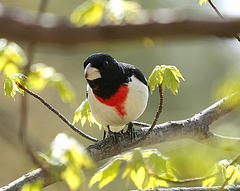 A new yard bird today! I don’t keep a written yard list, but am happy to add a new one to the *list* anyway! Lots of people get grosbeaks at their feeders, but what a surprise it was for me to pull into the driveway from work and see this guy feeding on stray sunflower seeds beneath the feeders. I’ve never even spotted them in the neighborhood before, but guess I could easily have missed them because their song is so similar to a Robin’s. I called my husband on the cell phone and told him to come to the kitchen window to see it. I woke him from a nap, but he was excited to see it anyway. I love spring migration and its many surprises! I didn’t have a chance to take a pic, but found this pretty one on flickr.com originally uploaded by RicKarr.
A new yard bird today! I don’t keep a written yard list, but am happy to add a new one to the *list* anyway! Lots of people get grosbeaks at their feeders, but what a surprise it was for me to pull into the driveway from work and see this guy feeding on stray sunflower seeds beneath the feeders. I’ve never even spotted them in the neighborhood before, but guess I could easily have missed them because their song is so similar to a Robin’s. I called my husband on the cell phone and told him to come to the kitchen window to see it. I woke him from a nap, but he was excited to see it anyway. I love spring migration and its many surprises! I didn’t have a chance to take a pic, but found this pretty one on flickr.com originally uploaded by RicKarr.
“The evening was calm and beautiful, the sky sparkled with stars. Suddenly there burst on my soul the serenade of the Rose-breasted bird, so rich, so mellow, so loud in the stillness of the night, that sleep fled from my eyelids. Never did I enjoy music more.” – John James Audubon quoted in For the Birds: An Uncommon Guide by Laura Erickson.
Erickson describes the grosbeak’s song as “like a Robin who takes voice lessons. [The song] is a long, rich warble. Robins sing long sentences, the words often three syllables – Rose breasted Grosbeak sentences can’t be broken into distinct words as easily.” For the Birds 5-29
In Bird Lore (1901) Emily B. Pellet describes the grosbeak’s song as a musical, “You’re a pretty bird. Where are you?” I think of it like a Robin’s, but in a deeper, more tenor voice and listen for its sharp “kick” call note.
Phragmites at North Pond
Photo of mom for Mother’s Day
 My brother calls this a *cheesecake* shot. I don’t know when or where it was taken, but love this pic of my mom long before she was a mother. She loved the beach so I imagine this was taken with the ocean or a lake nearby.
My brother calls this a *cheesecake* shot. I don’t know when or where it was taken, but love this pic of my mom long before she was a mother. She loved the beach so I imagine this was taken with the ocean or a lake nearby.
I was a little kid when my mom passed away and never had the chance to know her as anything other than my *mommy*. Sad really, when I see the friendships that my girlfriends have with their moms now that we’ve grown up. I rely on my brothers and old photos like this for glimpses into the person she was.
People tell me I look like her and my dad always said I had some of her mannerisms – one thing I know is that I could never look as good in a bathing suit!
NJ Audubon World Series of Birding
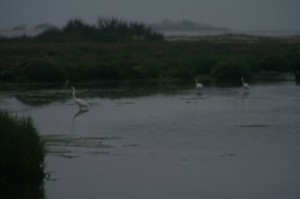 Great Egrets and Black-Crowned Night Herons at Plum Island
Great Egrets and Black-Crowned Night Herons at Plum Island
The following is the trip report sent via email by the team leaders and a few pics from the day.
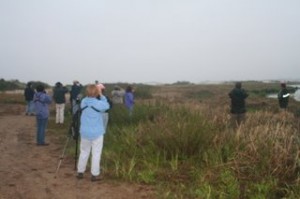 SHBO Century Run Team at Plum Island
SHBO Century Run Team at Plum Island
“The SHBO Sandy Hook Century Run today tallied 131 species between 5:30 am and 8:30 pm; much better than we anticipated given the rather weak migration this week and the dominance of easterly winds. Our day started off with a nice shorebird flight over Plum Island with 200+ Least Sandpipers, dozens of Black-bellied Plovers, Semipalmated Plovers, Greater Yellowlegs & Short-billed Dowitchers, 4 Lesser Yellowlegs, and 8+ Solitary Sandpipers. Our only Little Blue Heron, Black Skimmers, and Black-billed Cuckoo of the day were here also.
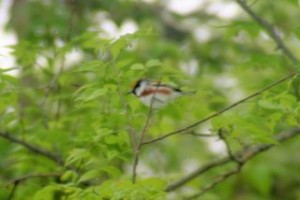
Chestnut-Sided Warbler
The Locust Grove was quite active with passerines today, highlights including a calling Alder Flycatcher, Yellow-throated Vireo, numerous warblers with a female Bay-breasted being the standout. A vocal Least Bittern was calling from the east end of North Pond. Lots of diurnal migrants overhead with flocks of Eastern Kingbirds and Blue Jays predominating.
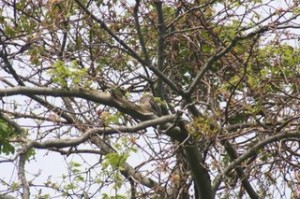 Dare ya to find the snoozing Nighthawk!
Dare ya to find the snoozing Nighthawk!
The Raccoon Alley area had a perched and oblivious Common Nighthawk, 6+ Blue-headed Vireos, Yellow-throated Vireo, Warbling Vireo (scarce migrant at the hook), Blackburnian Warbler, and Canada Warbler.
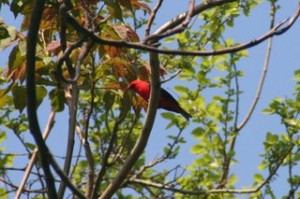 Scarlet Tanager
Scarlet Tanager
Saltmarsh Sharp-tailed Sparrows must have been migrating today: we saw 4-6 in the spartina marsh at Plum Island and there was another individual in the thick upland grass adjacent to k-lot. 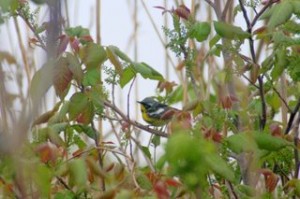
Magnolia Warbler in Poison Ivy. My favorite pic of the day.
After comparing notes at dusk and getting a sneak peak at the “Sandy Hook Platform Onlies” bird list, we have a preliminary total of 150 species for the hook today, including 23 species of warbler and a fly-by Mississippi Kite that passed the migration watch around 4:30 this afternoon.”
Final standings and more info on the World Series is available here.
International Migratory Bird Day
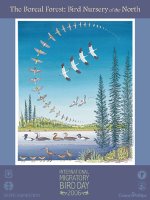 I missed a story on the way home from work on NPR about International Migratory Bird Day, but checked their website this evening and found a lot of wonderful links there. I’ve only been listening to NPR (WNYC 93.9) for the last year or so and wonder why I didn’t start listening sooner. Love them! Their website is great, too. A wonderful diversion for a few hours if you have the time. The link to today’s story and other interesting bird-related links can be found here.
I missed a story on the way home from work on NPR about International Migratory Bird Day, but checked their website this evening and found a lot of wonderful links there. I’ve only been listening to NPR (WNYC 93.9) for the last year or so and wonder why I didn’t start listening sooner. Love them! Their website is great, too. A wonderful diversion for a few hours if you have the time. The link to today’s story and other interesting bird-related links can be found here.
The image at left is this year’s poster by Radeaux and celebrates the theme of the boreal forest as the “bird nursery of the north”. Click on the image for more info.
I’ll be out tomorrow doing the “World Series of Birding” with Sandy Hook Bird Observatory. The weather doesn’t look too promising, but hopefully we’ll get plenty of birds. We’re meeting at 5:30 a.m. and will bird until dark. I doubt that I’ll last that long, but we’ll see!
Another book to look for
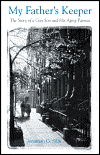 A dear childhood friend passed along a recommendation for this new book written by one of his colleagues at Bank Street College in Brooklyn. It sounds like a relevant read for anyone who is a caregiver or is concerned with the issues of aging parents. Another one to look for on my next stop at the bookstore.
A dear childhood friend passed along a recommendation for this new book written by one of his colleagues at Bank Street College in Brooklyn. It sounds like a relevant read for anyone who is a caregiver or is concerned with the issues of aging parents. Another one to look for on my next stop at the bookstore.
I wish that I had done some reading last year when I was caring for my dad. I’d imagine that many of the difficulties we faced are commonplace to families adapting to a parent who can suddenly no longer live independently due to illness. I also like to keep a list of books that make helpful gifts for friends facing difficult times. Once I’ve read this one, I may pass it along to a friend or two in need.
